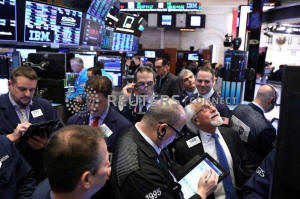|
Fed pause validates market fears about
U.S. growth
 Send a link to a friend
Send a link to a friend
 [February 02, 2019]
By Trevor Hunnicutt [February 02, 2019]
By Trevor Hunnicutt
NEW YORK (Reuters) - While the U.S. Federal
Reserve's indication it is done raising interest rates - for now - has
fueled stock gains, investors worry the U.S. central bank's pledge is a
double-edged sword and implicit confirmation of the markets' lingering
anxiety about growth.
Fed Chairman Jerome Powell said on Wednesday that U.S. economic growth
is "solid" and expected to continue. But in a sharp reversal of their
stance just six weeks ago, Powell said the Fed has "the luxury of
patience" in deciding whether to raise rates again.
The Fed's soothing message sent the S&P 500 up 1.6 percent on Wednesday
and extended into Thursday, helping the benchmark index post its biggest
January percentage gain since 1987.
But investors acknowledge that the Fed's strongest signal yet that
policymakers may have reached the end of its latest series of interest
rate increases could reflect slower economic growth.

"Both the stock and bond markets applauded the Fed for its more dovish
tone," said Michael Arone, chief investment strategist at State Street
Global Advisors. "If you take a step back and evaluate why they're doing
it, it's because they're concerned. So why shouldn't investors be
concerned?"
The U.S. bond market never fully bought into the enthusiastic tenor to
risk markets, including equities, year-to-date given signs of cracks in
the consumer and peaking corporate profit growth.
U.S. 10-year government bond prices are trading around the elevated
levels they commanded during last month's stock sell-off, with yields at
2.63 percent today compared with 2.69 percent on Dec. 31.
U.S.-based bond funds pulled in $16.7 billion in January, according to
early estimates from the research service Lipper. Investors took $944
million out of domestic stock funds over the same period.
"The bond market always gets it before the stock market," said Chuck
Self, chief investment officer at iSectors LLC. Stocks' sure-footedness
this year may end up like 2018's hot January rally only to peter out and
end in the negative.
Three- and 5-year yields are poised to dip below the 2.4 percent
effective Fed funds rate for the first time since 2006, before the
global financial crisis, noted Crescat Capital LLC analyst Otavio Costa
on Twitter.
Powell said there were "conflicting signals" about the economy - many of
them negative - including sharply slower growth in China and Europe,
Britain's chaotic exit from the European Union, U.S.-China trade
negotiations, effects of the U.S. partial government shutdown and
rougher markets.
[to top of second column]
|

Traders work on the floor of the New York Stock Exchange (NYSE) in
New York, U.S., January 30, 2019. REUTERS/Brendan McDermid

The Fed acknowledged that some market gauges of inflation have
fallen in recent months, a trend more typical of growth slowdowns
rather than an economy on fire.
The International Monetary Fund predicted the global economy will
grow at 3.5 percent in 2019, down 0.2 percentage point from last
October's forecasts, citing weakness in Europe and some emerging
markets. It puts U.S. growth at 2.5 percent this year and 1.8
percent in 2020, in both cases likely slower than 2018's figures,
which have not been finalized due to the government shutdown.
(Graphic: Fed's Powell vs S&P 500 - https://tmsnrt.rs/2TqIcyK)
"We're not favoring the U.S. market, but we're happy to own
Treasuries," said Schroders Plc portfolio manager Angus Sippe. He
said he does not see a recession on the horizon and gives the Fed an
"A-plus" on its management of the economy. But he would rather take
risk in emerging markets and wait for more evidence of U.S.
corporate earnings growth.
Financial research service Refinitiv expects 14.9 percent earnings
growth for the final quarter of 2018, but just 5.1 percent for all
of 2019, leaving less margin for error if consumer and business fear
translates into lower spending and investment.
Still, oil producers are working to stabilize prices, China is
aggressively stimulating its economy and, as Bank of America Corp
analysts said in a research note on Thursday, the Fed has shown that
its commitment to supporting markets is alive and well. Those
factors mean market pessimists are getting it wrong, according to
Michael Jones, chairman at RiverFront Investment Group LLC.
Some investors appear to be positioning for the worst.
Futures contracts tied to Fed rates imply the Fed's next move will
be a cut. Markets are pricing in a higher probability of two cuts by
next January than of a single rate hike.
(Reporting by Trevor Hunnicutt; editing by Jennifer Ablan and Lisa
Shumaker)
[© 2019 Thomson Reuters. All rights
reserved.]
Copyright 2019 Reuters. All rights reserved. This material may not be published,
broadcast, rewritten or redistributed.
Thompson Reuters is solely responsible for this content.
 |